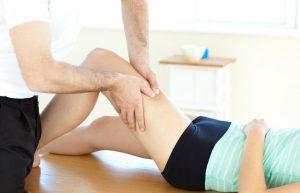For fitness enthusiasts, experiencing some muscle soreness is a sign of a good workout. However, continuous or increasing pain may be an indication of an underlying injury, which might get worse if left untreated.
The cause of your pain could be a result of incorrect technique or form while exercising. Functional movement testings are performed to determine which of your movement patterns may increase your risk of injury or reduced performance. This test is utilized as a baseline examination by Chiropractors, Physical Therapists and Athletic Trainers to gather data and determine a personalized course of improvement.
How Does Functional Movement Testing Work?
This screening test was created in 1997 by Cook and his colleagues to assist healthcare professionals to screen people for injury risk, as well as performance limiting and dysfunctional movement patterns. It is still used today as a tool to systematically rank and rate movement patterns and identify limitations that may cause pain or injury in the future.
The test consists of seven different exercises to check the movement patterns of an inpidual that require stability and mobility. The movement patterns are graded on a 3 to 0 scale, in which:
- 3: Unquestionable skill of performing the movement
- 2: Good skill of performing the movement, but certain degree of compensation is identified
- 1: Inability of performing or completing the movement
- 0: Pain is experienced when performing the movement
All the seven movement exercises are scored on this scale and the Chiropractor, Physical Therapist or Athletic Trainer will determine the next best action as per the score achieved. The seven exercise movement patterns included in functional movement testing are:
-
Deep Squat
The deep squat exercise tests coordinated thoracic spine, hip, and ankle mobility. It also demonstrates whether or not the patient has core stability with the shoulders and hips performing in symmetrical positions.
-
Hurdle Step
This second movement pattern helps in challenging the stride and stepping mechanics of the body. Moreover, it tests the control and stability in a single leg stance. This is an effective means of determining the symmetry on both sides while also assessing the balance and mobility of the hip.
-
In-Line Lunge
The in-line lunge is a quick assessment of the right and left function in a simple pattern and aims to position the body to focus on the stresses stimulated throughout the lateral, deceleration and rotation movements.
-
Shoulder Mobility
This screen test identifies the natural flow and rhythm of the rib cage, thoracic spine, and scapular-thoracic region with the reciprocal upper extremities of the shoulder movements.
-
Active Straight-Leg Raise
For this exercise, the patient will lay on their back to check the mobility of their flexed hip while the opposite hip stays flat and extended on the ground. It is also used to identify initial core stability. The goal of this exercise is to determine the capability of disassociating the lower extremities as the patient tries to maintain stability in the core and pelvic region.
-
Trunk Stability
The trunk stability test observes the stabilization of the reflex core but is not utilized as a measurement of strength. The test is to begin the movement with the upper body extremity without moving your pelvis or hips.
-
Rotary Stability
The last screen test is a complex movement that involves proper coordination and energy transfer on either side of the body through the torso. It helps in observing weight shifts, reflex stabilization, as well as coordination of stability and mobility in a climbing pattern.
By performing these exercises, your healthcare expert will be able to identify any weak links in your body that might be causing pain. As you and your team of medical professionals continue to work on those limited movements, you will reduce your risk of injury and enhance your performance.
Benefits of Functional Movement Testing
Functional movement testing offers numerous benefits to the inpiduals—especially fitness professionals.—Here are some of the benefits that functional movement testing offers:
- Provides a standardized tool to appraise movements through an objective approach. This decreases the subjectivity when the determining the effect of rehabilitation and exercise on movements.
- Improves the communication between the healthcare providers and patients as the standardized tool offers a common measuring system. This is mostly because the data can be shared and assessed accurately by different inpiduals.
- Highlights the main issues or limitations in the movement. The screen tests are usually completed within 10 minutes. This allows the professionals a time-saving tool to figure out whether or not they have a problem. This screening even saves time when conducted among bigger groups.
- This test doesn’t require use of much equipment which makes is practical for all populations and professionals to use. The minimal equipment usage makes it an effective tool for screening groups of people as well.
- The seven inpidual movement patterns allow the health professionals to examine different areas of the body using mobility and stability for narrowing down the possible problems in the body.
Functional movement testing provides valuable information to healthcare professionals as it determines the ideal corrective exercises an inpidual needs to improve their mobility and stability. A low score will indicate a sign of risk and allow your Physical Therapist, Chiropractor or Athletic Trainer to create a treatment plan accordingly.
Our Athletic Trainers at Alliance Orthopedics offer a one-on-one session with each patient at the beginning of their treatment to gain statistics on strength and body movements. Whether you are looking for treatment and diagnosis of orthopedic concerns, spine issues, sports injuries, or want nutritional counseling, book your appointment today! We aim to help you get better faster and improve your fitness and performance.

